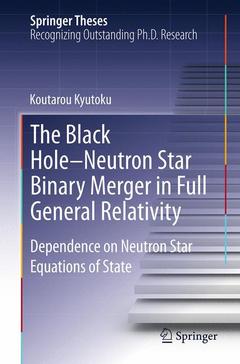Description
The Black Hole-Neutron Star Binary Merger in Full General Relativity, 2013
Dependence on Neutron Star Equations of State
Springer Theses Series
Author: Kyutoku Koutarou
Language: English
Subject for The Black Hole-Neutron Star Binary Merger in Full...:
Keywords
Adaptive Mesh Refinement; Black Hole-neutron Star Binary; Compact Binary Coalescence; Gravitational Waves from Compact Binaries; Neutron Star Equation of State; Numerical Relativity for Non-vacuum Spacetimes; Piecewise Polytropic Equations of State; Short-hard Gamma-ray Bursts; Supranuclear Density Matter; The Tidal Disruption of Neutron Stars
Publication date: 06-2015
Support: Print on demand
Publication date: 01-2013
178 p. · 15.5x23.5 cm · Hardback
Description
/li>Contents
/li>Biography
/li>Comment
/li>
This thesis presents a systematic study of the orbital evolution, gravitational wave radiation, and merger remnant of the black hole?neutron star binary merger in full general relativity for the first time. Numerical-relativity simulations are performed using an adaptive mesh refinement code, SimulAtor for Compact objects in Relativistic Astrophysics (SACRA), which adopts a wide variety of zero-temperature equations of state for the neutron star matter.
Gravitational waves provide us with quantitative information on the neutron star compactness and equation of state via the cutoff frequency in the spectra, if tidal disruption of the neutron star occurs before the binary merges. The cutoff frequency will be observed by next-generation laser interferometric ground-based gravitational wave detectors, such as Advanced LIGO, Advanced VIRGO, and KAGRA.
The author has also determined that the mass of remnant disks are sufficient for the remnant black hole accretion disk to become a progenitor of short-hard gamma ray bursts accompanied by tidal disruptions and suggests that overspinning black holes may not be formed after the merger of even an extremely spinning black hole and an irrotational neutron star.
Equations of State of Neutron Star Matter.- Computing Initial Conditions.- Methods of Simulations.- Diagnostics for Numerical Simulations.- The Merger of Nonspinning Black Hole-Neutron Star Binaries.- The Merger of Spinning Black Hole-Neutron Star Binaries.
Cosmophysics Group, Theory Center, IPNS (Institute of Particle and Nuclear Studies), KEK (High Energy Accelerator Research Organization)
kyutoku@post.kek.jp
These books may interest you

Scalar Fields in Numerical General RelativityInhomogeneous Inflation and Asymmetric Bubble Collapse 105.49 €

Scalar Fields in Numerical General RelativityInhomogeneous Inflation and Asymmetric Bubble Collapse 105.49 €

Compact Star Physics 75.14 €

